“At night, a pervert dug up the grave, smashed the coffin and profaned the body, then carved the corpse. After the act, he stole the deceased's clothes. Krakow, 1938.
Canute Tangey spoke of necrophilia with disgust, but also in detail. "It [is] the most horrible form of sexual perversion that consists in lasciviously insulting dead bodies," he wrote in Sexual Deviations in the Light of Science published in Polish in 1912. - "It is always associated with a deep mental disorder, because the image itself is terrible and disgusting, against which the mentally sane is reluctant, here it is associated with a feeling of delightful pleasure".
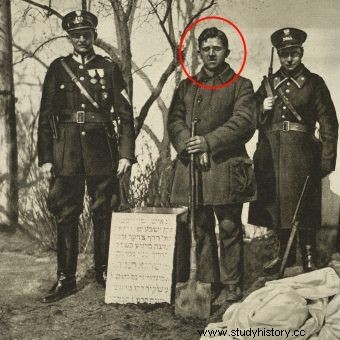
Necrophile from Żyrardów. Press illustration from 1930
The author cited a French criminal case from the mid-nineteenth century as an example. The criminal was a man "from a more noble family." Immediately after watching over the body of a 16-year-old girl, he sneaked into the mourning chamber, bribing the only witness on the way. In the middle of the night:
(...) a noise was heard in the room, as if a heavy piece of furniture had tipped over. The mother of the deceased burst into the room and saw a man in only a shirt, jumping out of the bed of the dead woman. At first it was thought it was just a thief, but soon it was displayed.
The investigation found that the man had already desecrated the bodies of the dead girls. Property and connections could not help him now. The court sentenced him to life imprisonment.
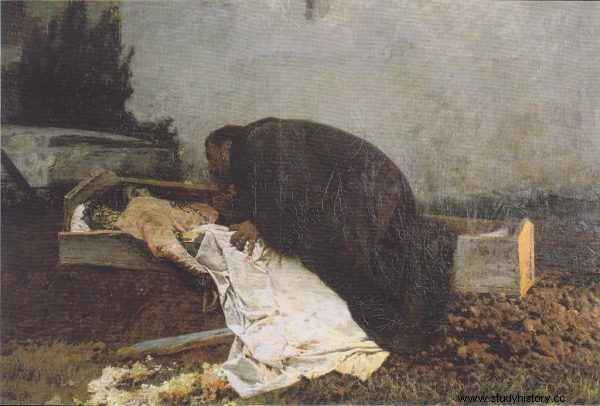
Pietro Pajetta, "Hatred". Picture from 1896
It is not known what was the further fate of the degenerate. Perhaps, after some time, the prison sentence was changed to compulsory hospitalization. It was a common trend in Europe. The provisions on necrophilia were removed from the penal codes, assuming that in such cases the intervention of a doctor, not a public prosecutor, was necessary.
The traditional regulation lasted the longest in Switzerland. Until 1896, the profanation of a corpse was punished there as one of the varieties of "harlotry against nature". In 1925, however, Stefan Glaser, a carnivore from Vilnius, emphasized:"We do not find shame of a corpse for sexual purposes [anymore] in any legislation."
"Classification of hypererotics". Pre-war experts on the phenomenon of necrophilia
Magnus Hirschfeld, the director of the Sexological Institute in Berlin, also touched upon the topic of necrophilia. He created a classification of "hypererotics", ie people engulfed in an extremely strong and unstoppable sex drive. "The forms in which this hypererotism can manifest itself are extremely diverse," he explained. Among other things, he pointed to a tendency towards zoophilia, obsessive swearing and insults, rape or even sexual murder. Also on the list was a tendency to "corrupt the dead."
His argument would suggest that necrophilia was by no means an extremely rare deviation. It was a symptom of a relatively common disease. Similarly, Polish expert, venereologist Paweł Klinger, wrote about her as if you would meet rapists every day. And he even tried to rationalize their behavior.
Necrophilia. By this name we understand, in the full sense of the word, harlotry with corpses (...). Those who indulge in this perversion are people who, because of their profession, have close contact with corpses, such as gravediggers, cemetery caretakers or professional body guards. The occasion may contribute to this when, by chance, the person, while alone with a corpse, is sexually aroused.
Klinger had a lot to say about theoretical issues. He drew attention to the sadomasochistic aspects of necrophilia, as well as the mental disorders associated with this deviation. However, he was unable to identify any specific examples. He referred to fiction (a few sentences mention of the tabloid novel The greatest betrayal sounds almost like a review), as well as to the popular theme of "belief in vampires."
However, tangibly Klinger met only with "the so-called symbolic necrophilia":
The point is that a pervert of this kind tells his partner to "do" a corpse, otherwise he cannot be sexually satisfied. Usually, in houses of debauchery, a prostitute, who plays this role, dresses up in a mourning garment and is placed on a "deathbed", in a room covered with a cairn, with candles lit etc. Then the pervert satisfies his abnormal sex drive one way or another.
This is probably a real necrophiliac who only lacks the courage to turn into action the products of his morbid fantasy .
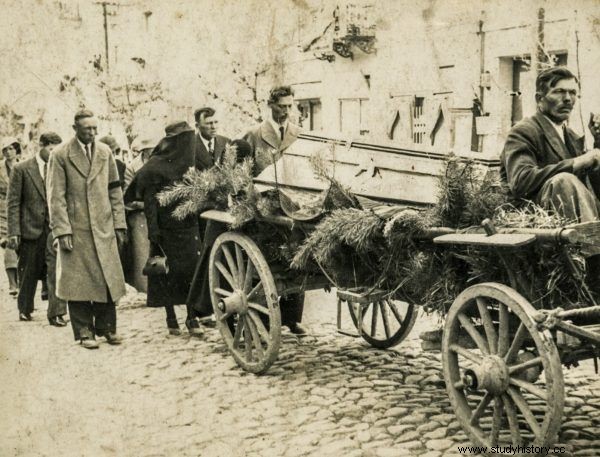
A village funeral procession in the 1930s. Illustrative illustration.
Similar cases were also known to the author of the entry Necrophilia published in the Polish Encyclopedia of Sexual Knowledge from 1937. He doubted, however, whether it was a secret necrophilia or a sexual fascination with… sleeping women. Because, however, mourning costumes and cuiras were already an extremely rare staging. The conclusion was, "Whether such a propensity really exists - has not yet been finally ascertained."
Difficulties in interpretation. Does a pervert always mean a pervert?
The media can be of some help in tracing the truth. The degenerates who disgraced the corpse were mentioned from time to time in the newspapers. They were referred to as "perverts" and "degenerates." However, it should be remembered that these words were understood much more broadly before the war than today. Any person with a dislocated psyche was a pervert. And it didn't have to be a sexual perversion at all.
In 1929, it became loud about a certain Gerhard Doora, arrested in Bydgoszcz. "Door, the son of wealthy parents near Starogard, started studying spiritism and black magic after graduating from four high school classes," reported the daily Ilustrowana Republika. The man "profaned graves and desecrated bodies."
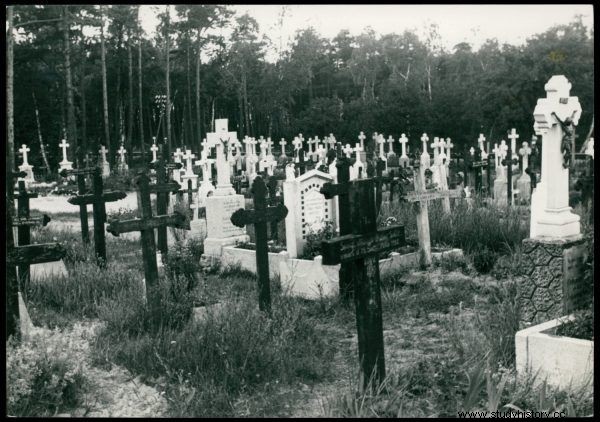
Cemetery in Jastarnia. Photo from 1935
The pages of "The Advocate of Ostrowski and Odolanowski" enumerate a huge collection of items that Door took from the cemetery. In his apartment, the policemen found:
(...) a dozen or so screws, unscrewed from the coffins of the dead (...), pieces of clothing, torn off the dead, breviaries, stolen in the tombs of deceased priests and a dozen or so unburned candles.
Two old tables of the Ten Commandments were found, probably taken from some grave in the Jewish cemetery. Then two crosses were found, one of which was torn off the lid of the coffin, the other was taken from the hands of the deceased, cuiras with which to cover the catafishes and other similar things (...).
In addition, this individual had two human skulls in his apartment, most likely also from the cemetery .
Both newspapers hailed the inhabitant of Bydgoszcz as a "pervert". However, there is no indication that he had committed any bodily acts with the dead. He was an occultist, a charlatan, and probably also a mentally unstable man. But he cannot be considered a necrophile.
"The terrible rake of linen coffins." Polish cases
There were more similar cases. In some cases, the newspapers omitted key details, so the nature of the deviation completely eludes assessment. In others, you can see at first glance that they are about graveyard hyenas, and not erotic degenerates. The 1930 scandal near Warsaw should be considered a rare exception to the rule. The weekly illustrated "Światowid" reported:
A degenerate criminal. The gravedigger of the Jewish cemetery in Żyrardów, Jan Dudziński, for a long time engaged in the terrible practice of digging up graves and raking linen from coffins, in which the bodies of the dead were wrapped. According to the further investigation conducted by the police in this case, the degenerate criminal was also alleged to have profaned the bodies buried in the women's cemetery .
A no less disgusting act of necrophilia took place in the capital of Lesser Poland in 1938. Again, there can be no doubt about the erotic nature of the offense.
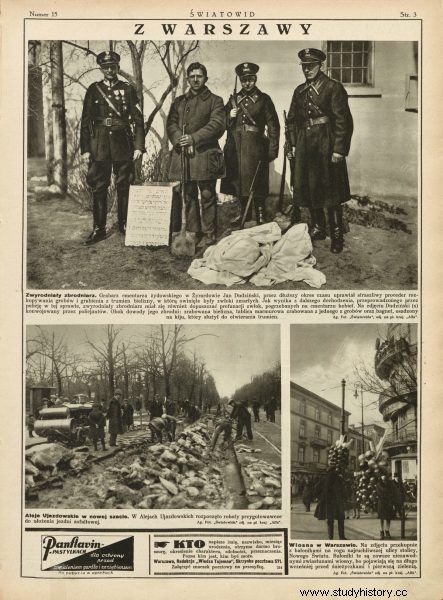
Photo gallery with a photo of a "degenerate criminal" from Żyrardów. Apart from the information about the reconstruction of Aleje Ujazdowskie and about the "spring in Warsaw".
As reported by "Krakowski Kurier Wieczorny":
In Prokocim, a great stir was caused by the hideous crime of a necrophile pervert. A few days ago, a 17-year-old girl was buried in the cemetery. She died after a long, debilitating disease. During the night, the pervert dug up the grave, smashed the coffin and profaned the corpse, then carved the corpse. After the act, he stole the clothes of the deceased. The local police have started an investigation and are already on the trail of the pervert .
It is not known whether the perpetrator was successfully apprehended. The newspapers rarely returned to petty, macabre matters. Maybe necrophilia didn't happen every day, but every number was bursting at the seams with suicides, beatings, murders and frauds. It was easier to write about what had just happened than to discuss matters that were already out of date. The police, at any rate, had no doubts that the necrophilia phenomenon existed.
In Krakow, a special circular was even issued explaining what crimes are related to "perverted sex drive". It was emphasized that these degenerations were "very frequent and so varied that the facts surpassed all expectation." The list included erotic "desecration of corpses."
